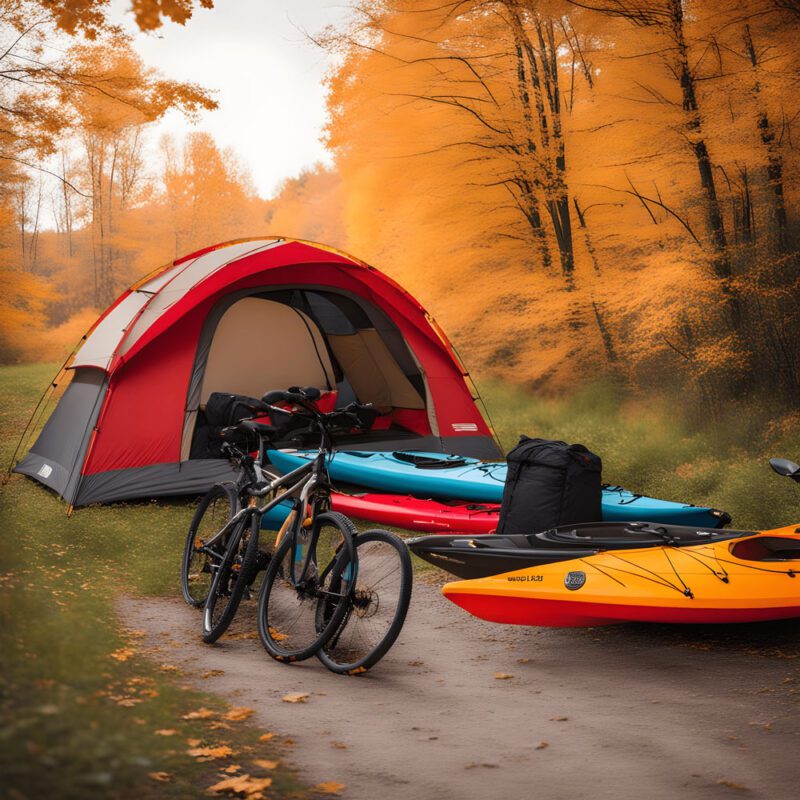From Summer Thrills to Winter Chill: Mastering the Art of Self-Storage for Your Outdoor Gear
 As autumn leaves paint the landscape with hues of red and gold, the time has come to bid farewell to the sun-soaked adventures of summer. For biking, kayaking, and camping enthusiasts, this seasonal transition means more than just swapping out wardrobes—it’s about safeguarding the tools of outdoor bliss against the icy embrace of winter. In this comprehensive guide, we embark on a journey through the intricacies of self-storage, exploring the steps and strategies to ensure your cherished summer gear emerges unscathed and ready for action when the thaw arrives.
As autumn leaves paint the landscape with hues of red and gold, the time has come to bid farewell to the sun-soaked adventures of summer. For biking, kayaking, and camping enthusiasts, this seasonal transition means more than just swapping out wardrobes—it’s about safeguarding the tools of outdoor bliss against the icy embrace of winter. In this comprehensive guide, we embark on a journey through the intricacies of self-storage, exploring the steps and strategies to ensure your cherished summer gear emerges unscathed and ready for action when the thaw arrives.
Assessing the Seasonal Shift
Before diving into the logistics of self-storage, it’s crucial to understand the seasonal impact on your outdoor gear. Winter introduces challenges such as temperature fluctuations, moisture, and potential damage from prolonged disuse. Recognizing these factors sets the stage for an effective storage plan tailored to the unique needs of your equipment.
Cleanliness is Next to Longevity
The first commandment of successful self-storage is cleanliness. Bikes caked in mud, kayaks adorned with river residue, and camping gear tinged with the smell of campfires—all require meticulous cleaning. Dive into the details of washing, degreasing, and drying each item, ensuring no hint of summer grime remains. For bikes, a final tune-up is not just recommended; it’s a prerequisite for a smooth ride come spring.
Choosing the Right Storage Property
Not all storage units are created equal, and the selection process is akin to finding a sanctuary for your outdoor companions. Explore the features of storage properties, emphasizing climate control, security measures, and size considerations. A climate-controlled unit acts as a shield against temperature extremes, preventing the harsh winter cold from taking a toll on your gear. Security features, including surveillance systems and secure access, provide peace of mind, ensuring your equipment is protected against potential theft or vandalism.
Mastering the Art of Bike Storage
Bikes are not mere objects; they are extensions of personal freedom and exploration. To ensure they roll into the next season unscathed, follow these steps:
Elevate and Suspend:
Invest in sturdy bike hooks or specialized racks to suspend your bikes. This not only frees up valuable floor space but also prevents flat spots on the tires.
Accessory Detox:
Strip your bike of accessories vulnerable to cold temperatures. Electronic gadgets, lights, and other delicate add-ons should find shelter in a climate-controlled space.
Cover with Care:
A breathable fabric cover shields your bikes from dust without trapping moisture. Choose a cover that fits snugly, offering a protective cocoon for your trusty steeds.
Inflate and Lubricate:
Check tire pressure before hanging up your bikes. Adequate inflation prevents flat spots. Give the chain and other moving parts a final dose of lubrication for added protection against winter dryness.
Kayaks: Storing Your Watercraft with Care
Kayaks, vessels of exploration and serenity, demand a storage strategy that preserves their form and function:
Upside Down Wisdom:
Store kayaks upside down to prevent warping of the hull. This position also discourages water accumulation, a potential breeding ground for mold and mildew.
Cushion the Impact:
Place foam blocks or padding beneath the kayak to distribute weight evenly. This safeguards the structural integrity of the hull, ensuring your kayak remains ready to glide through the waters.
Cover for Protection:
Shield your kayak from the elements with a purpose-built cover. Opt for materials that are not just protective but also breathable, preventing the formation of condensation.
Camping Gear Haven
Camping gear, imbued with the essence of outdoor escapades, deserves the winter refuge that will keep it in tip-top condition:
Catalog and Bin:
Take inventory of your camping gear, categorizing items by type and frequency of use. Opt for clear plastic bins to protect against dust and pests while allowing for easy identification.
Moisture Management:
Combat the winter humidity by placing moisture-absorbing packets or desiccants in each bin. This proactive measure prevents mold growth and preserves the freshness of your gear.
Inspect and Repair:
Before storage, scrutinize your camping gear for wear and tear. Mend any small tears, replace worn-out components, and ensure that zippers and closures are in optimal condition.
The Finishing Touch: Organization
A well-organized storage unit is more than a protective cocoon; it’s a time capsule waiting to unlock memories. Invest time in labeling bins, arranging items systematically, and creating a mental map of your storage space. The organization ensures easy retrieval when the seasons change.
More than a seasonal chore—it’s a ritual
Transitioning your summer gear into self-storage is more than a seasonal chore—it’s a ritual of respect for the tools that have accompanied you on countless adventures. By understanding the nuances of cleaning, choosing the right storage property, and implementing thorough storage techniques, you’re not just safeguarding expensive equipment; you’re preserving the essence of outdoor exploration.
As you lock the door to your storage unit, envision it as a portal to future adventures. Winter may have its icy grip, but within the confines of your storage unit, the spirit of summer remains resilient, patiently waiting for the call of warmer days.





